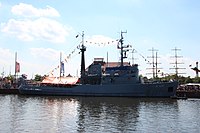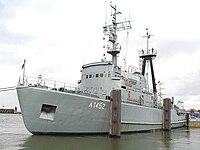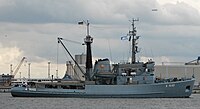Wangerooge class
|
|
||
|---|---|---|
| Wangerooge class | ||

|
||
| Class details | ||
| Ship type : | Sea tug | |
| Ship class: | 722 | |
| Units: | 6th | |
| Type ship: | Wangerooge (A 1451) | |
| Sister ships: |
Spiekeroog (A 1452) Langeoog (A 1453) Baltrum (A 1454) Norderney (A 1455) Juist (A 1456) |
|
| Builder: | Schichau Unterweser AG , Bremerhaven | |
| Keel laying: | 1965 to 1967 | |
| Commissioning: | 1968 to 1971 | |
| Technical specifications | ||
| Displacement: | 1,093 ts | |
| Length: | 51.78 meters | |
| Width: | 11.77 meters | |
| Draft: | 4.1 meters | |
| Drive: |
Diesel- electric drive 4 MWM diesel engines with three-phase generators 2 DC traction motors with a total of 2,068 HP |
|
| Fuel supply: | 175 m³ | |
| Speed: | 13.6 kn in shallow water | |
| Crew: | between 20 and 33 (civil) depending on the conversion version | |
| Armament: | until 1991: a 40 mm Bofors gun (cocooned) with an OGR-7 aiming column | |
The auxiliary ships of the Wangerooge class (officially: Class 722 ) are sea tugs of the German Navy . Their main task is to tow and recover vessels and to provide assistance at sea. The towing of targets and the recovery of exercise torpedoes and mines is another task of the sea tugs.
General
As part of the shipbuilding program of 1960, Schichau Unterweser AG in Bremerhaven received the order to build six class 722 sea tugs. They have a steel hull with a Maier shape and ice reinforcement , which is divided into VIII departments. The superstructures are made of light metal and there is NBC protection.
All units in this class were given names from the East Frisian Islands and have or had civilian occupation.
With the exception of the Spiekeroog , all sea tugs were decommissioned and put up again after a short time due to the reduction in personnel in the Navy as part of a structural change.
Two of the units were later put back into service as sea tugs. The other three were converted into school boats.
As part of retrofitting and retrofitting, the sea tugs were later reclassified: Wangerooge - 722C, Spiekeroog - 722B and Norderney - 722B1.
units
- 722/01 Wangerooge (since 1968)
The Wangerooge was put into service on April 8, 1968 for the 2nd supply squadron . The home base was Wilhelmshaven . As early as October 31, 1969, she was decommissioned in the Naval Arsenal , then mothballed and placed under the reserve flotilla. On July 1, 1970, the Wangerooge was put back into service for the 2nd supply squadron in Wilhelmshaven. With the amalgamation of the 1st and 2nd supply squadrons to form the Trossgeschwader on March 25, 1997 nothing changed for the Wangerooge , it remained stationed in Wilhelmshaven.
A standard task for the Wangerooge is the support of the naval operation school with "survival training at sea" (Open Sea Survival Training). Here, under real conditions in wind and rough seas, aircraft crews practice jumping from the stern of the tug into open water and then rescuing them on the life raft.
On December 19, 1989 , the Wangerooge was the first unit with a civilian crew to receive the so-called “Nikolauspreis” of the ship safety teaching group in Neustadt in Holstein as the best annual achievement in ship safety training.
- 722/02 Spiekeroog (since 1968)
On August 14, 1968, the Spiekeroog and the Langeoog were put into service together for the 1st supply squadron. They were stationed at the naval base in Kiel . The amalgamation of the 1st and 2nd supply squadrons to form the Trossgeschwader on March 25, 1997 changed nothing for the Spiekeroog , it remained stationed in Kiel. At times, the Spiekeroog was / will be parked for security tasks with the 1st and 3rd submarine squadrons .
In the Kiel Fjord on February 8, 1975, there was a collision between the Spiekeroog and the Liberian freighter Butterfly with only minor damage.
- 722/03 Langeoog (1968–1977)
On August 14, 1968, the Langeoog and the Spiekeroog were put into service together for the 1st supply squadron. They were stationed at the naval base in Kiel . In Wilhelmshaven, the Langeoog was decommissioned on February 14, 1977 and then launched there.
After the Langeoog had been rebuilt in the Mützelfeldtwerft in Cuxhaven , it was put into service as a mine throwing and light boat of class 754 on June 6, 1978 with civilian crew for the naval weapons school as a replacement for the Eider .
The Langeoog is now to be scrapped in the Netherlands.
- 722/04 Baltrum (1968–1969)
The Baltrum was put into service on October 8, 1968 for the 2nd supply squadron with its home base in Wilhelmshaven. On March 14, 1969, she was decommissioned, cocooned and placed under the reserve flotilla on April 1, 1969.
On September 2, 1974, the Baltrum was put into service as a class 754 diving school boat for the Technical Naval School I , ship safety teaching group, in Neustadt in Holstein as a replacement for the TM 1 diving school boat , initially with a military crew.
- 722/05 Norderney (1970-2002)
The Norderney (A 1455) belonged to the 2nd and later to the 1st supply squadron. She was decommissioned on November 22, 2002 and put back into service the same day as ROU 23 Maldonado for the Uruguayan Navy .
- 722/06 Juist (1971–1976)
On October 1, 1971, the Juist was put into service for the 2nd supply squadron in Wilhelmshaven. It was then made available to the naval arsenal in Kiel. In the naval arsenal Wilhelmshaven, the Juist was decommissioned and launched on July 15, 1976.
After the renovation of the Juist in the Mützelfeldtwerft in Cuxhaven, it was put into service as a class 754 diving school boat on February 24, 1978 for the Technical Naval School I, ship safety teaching group, in Neustadt in Holstein, initially with a military crew as a replacement for the Ems diving school boat .
Technical specifications
Diesel-electric propulsion system
- four Maybach four-stroke 16-cylinder diesel engines with 442 kW (600 hp) each
- four drive generators with 405 kW each
- two propeller motors with 820 kW each (together 2000 HP)
- two three-wing screws, each 2.30 m Ø
- two oars
Electrical system
- four diesel generators each with 136 kW (195 PS / 150 kVa)
Armament
- Initially a 40 mm Bofors gun , which was initially cocooned and later (1991) expanded
equipment
- Towing gear
- a 5 t boom
- two fire monitors
- two bow anchors in side hulls
- a stern anchor in anchor bag
- two motor cutters
- one or two inflatables
- three life rafts
| Surname | Identifier |
Call sign until Nov. 30, 1981 / from Dec. 1, 1981 |
Construction number |
Keel laying | Launch | Indienst- position |
Außerdienst- position |
Whereabouts | image |
|---|---|---|---|---|---|---|---|---|---|
| Wangerooge | A 1451 | DSHU / DRLI | 1735 | October 1, 1965 | 4th July 1966 | April 9, 1968 |

|
||
| Spiekeroog | A 1452 | DSHV / DRLJ | 1736 | November 20, 1965 | September 26, 1966 | August 14, 1968 |

|
||
| Langeoog | A 1453 | DSHW / DRNN | 1737 | July 12, 1966 | May 2, 1967 | August 14, 1968 | February 14, 1977 | Mine throwing / light boat (Class 754) |
|
| Baltrum | A 1454 | DSHX / DRNL | 1738 | September 29, 1966 | June 2nd, 1967 | October 8, 1968 | March 14, 1969 | Diving school boat (class 754) |

|
| Norderney | A 1455 | DSHY / DRLJ | 1739 | May 9, 1967 | February 28, 1968 | October 15, 1970 | November 22, 2002 | Uruguayan Navy |
|
| Juist | A 1456 | DSHZ / DRNM | 1740 | September 23, 1967 | 15th August 1968 | 1st October 1971 | July 15, 1976 | Diving school boat (class 754) |

|
See also
Remarks
- ↑ The technical term (in) cocooning used in the navy includes the preservation and (airtight) sealing of a device or even an entire ship. In shipping, a ship that has been taken out of service is called a trailer . Colloquially, this process is also called "mothballing".
Web links
Footnotes
- ^ German Navy: Sea tug Wangerooge class 722B. German Navy, July 21, 2007, accessed June 12, 2010 .
- ↑ Siegfried Breyer, Gerhard Koop: The ships and vehicles of the German Federal Navy 1956 until today. Bonn 1996, ISBN 3-7637-5950-6 .
- ↑ Chronicle of the Supply Flotilla, 1956–1994
- ↑ List of ship numbers (2004) ( Memento of March 4, 2016 in the Internet Archive ), p. 29 (PDF; 782 kB)
- ^ A b Wolfgang Harnack: The destroyer flotilla of the German Navy from 1958 to today. Köhler, Hamburg 2001, ISBN 3-7822-0816-1 .
- ^ Frank Binder: Last trip of the "Langeoog" , THB - Deutsche Schiffahrts-Zeitung , October 2, 2017.